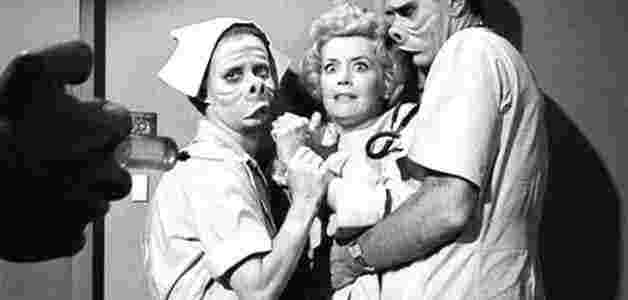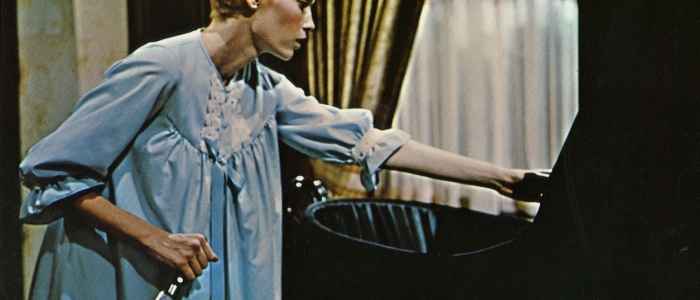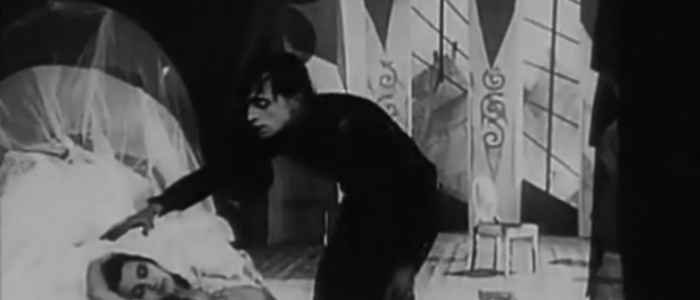Vague Horror: The Scariest Kind of Horror
“Give me just enough information so that I may lie convincingly.” -Stephen King

Like Life, Good Horror is Vague
When it comes to good horror, the kind shaking the foundation of one’s perspective, vague implication is more effective than cheesy, volume-on-eleven, growling-monster-suddenly-in-your-face schlock. The most terror-filled television and cinema are both bloodless and blood curdling, achieving their terror through vagueness and implication, not making viewers jump for a second, but entering into – and more importantly, remaining in – one’s consciousness long after a film ends.
Human consciousness – as described by the narrator in Vonnegut’s Deadeye Dick – is a peephole opening slowly from infancy to view life. Likewise, an audience’s peephole must accept a slowly unfolding narrative that keeps secrets. Rather than weak storytelling, vagueness is strong, mirroring reality.
“We are just a biological speculation,” Funkadelic wrote, “sitting here vibrating, but we don’t know what we’re vibrating about.” Our peepholes see but don’t understand. We stand on the shoulders of giants in various fields, but struggle with morality. Looking toward the past, the origin of life remains a mystery. We cannot prove or disprove God’s existence, and science and religion fail to answer the angst-filled questions of our mortal coil. In the end, religious or not, we take much on faith to explain our peepholes’ incomprehension.
Vagueness in Television Horror

On television, the vague, terrifying Twilight Zone series first opened our peephole was to alternate realities. From its onset, viewers accepted, without explanation, twilight zone mysteries. In the episode, Eye of the Beholder, for example, aesthetics are reversed and the porcine elite banish the beautiful. Peepholes suddenly opened to a terrifyingly confusing world, our minds run to personal questions to fill these mysterious story gaps. “Where are they sending her?” “Could anyone win against this society?” “Would I, like the woman in the episode, succumb to cosmetic surgeries?” As in life’s narrative, meaning is not dictated, and the narratives we create to fill the lapses – our world within the world – are supremely terrifying
Our peepholes open to another episode of The Twilight Zone, It’s a Good Life, in which a boy, Anthony, reads minds and kinesthetically punishes negative thinkers. We accept Anthony without distracting backstory, focusing instead on the horror of living under an omniscient, vindictive autocrat punishing adults for his youthful naïveté. The episode is highly ironic: Its title is a lie, truth incurs Anthony’s wrath, and challengers are destroyed; also, Anthony himself is negative, and selfishly subdues truth and music to protect himself from uncomfortable feelings. A discussion of Anthony’s idiosyncracies, though, transforms a visceral horror story into an intellectual character study. For horror’s sake, Anthony’s past is left unseen.
Cinematic Vagueness
Similarly, The Sixth Sense uses a story lapse to create a cinematic tromp l’eoil. We see psychologist, Malcolm Crowe – after recovering from a bullet wound – befriend a boy, Cole Sear, who claims that his peephole can “see dead people.” The film’s climax shows that what seemed clear – Dr. Crowe’s post-gunshot life – is illusion, and what was vague – Cole seeing dead people – is real. Likewise, the apparently corporeal, Dr. Crowe, is revenant. The climax showed that our peepholes saw nothing.
Vagueness and implication create virtually all terror in Rosemary’s Baby (1968), the story of Rosemary Woodhouse, whose husband, Guy, volunteered her to unwittingly carry Satan’s baby to advance his career. When Satan rapes Rosemary, we see only his eyes. Similarly, our peepholes see the hideous infant briefly, while a Satanist tells Rosemary, “He has his father’s eyes.”
Literally, Rosemary’s Baby concerns the antichrist, and Rosemary’s literal horror is that she carries the devil’s child. Her deeper horror, however, is also subtler: her “lover” volunteered her for this. Sadly, Guy’s world of duplicitousness and contradiction has become Rosemary’s world: smiling neighbors secretly seeking Satanic strength, a husband’s lust for fame and fortune, a mother’s sacred womb carrying evil, and a curse fulfilling the promise of a blessing. Such morbid betrayal is the greatest terror in Rosemary’s Baby because it begs the question, “Do I really know my lover?”

Like Rosemary’s Baby, Nathaniel Hawthorne’s Young Goodman Brown is a story of faith misplaced in a false lover. Young Goodman Brown’s peephole witnessed in the night forest his seemingly pious wife as a secret “fiend worshipper.” Faith Brown’s initial vagueness strengthens her believability, mystery, and horror. Also like The Sixth Sense, Young Goodman Brown has a headspinning climax clarifying built on preceding vagueness.
Likewise, Young Goodman Brown’s epiphany reveals contradictions and irony dependent on vagueness. For example, Faith Brown’s vague characterization leads our peepholes to trust what Mr. Brown’s peephole has seen: she is harmless, good, and trustworthy; in fact – and these facts are brilliantly veiled by vagueness – Faith Brown is evil, untrustworthy, and harmful. Similarly, Guy Woodhouse’s lack of backstory strengthens his believability and universality. After all, like Walter White, Guy’s mantra could be that he, like any good husband, did “everything for family.” Hence, Guy represents not some generic “guy,” but that somewhat vague lover asleep on the next pillow, head full of (nefarious?) dreams.
Dr. Caligari: Master of Vague Cinematic Horror

Opening our collective peephole to vague cinematic horrors was The Cabinet of Dr. Caligari (1920), a masterpiece of cinematic implication. First, the lack of explanation makes Caligari’s inexplicable architecture even eerier. The jagged, leaning buildings and broken windows create a vague sense of the macabre. (In this regard, the film recalls Laurel and Hardy’s 1934 Babes in Toyland.) Windows – peepholes to the outside world – are also slanted at bizarre angles without explanation. Another odd, ironic detail is that amongst such strange angles, two things lie in perfectly straight lines: Dr. Caligari’s hair, though usually under his hat, and glove seams. In Caligari’s world, everything – including straight and crooked – is reversed.
Dr. Caligari’s vagueness encourages the mind to fill in what the peephole has not seen. After the town clerk ignores Caligari, the former is killed while sleeping. The clerk’s corpse is unseen, while three police officers stand over his bed, his odd-shaped window recalling a coffin. The policemen leave the body to look out the misshapen, broken window, foreshadowing their inability to solve the murders.
Caligari: Master of Sleeping Cesare

At the fair, Caligari hawks the experience of seeing Cesare the Somnambulist who, according to Caligari, has slept his whole 23-year life. Caligari says he is Cesare’s master, and tells Cesare, whose cabinet resembles a coffin, to wake from his “dark night.” When Cesare awakens, Dr. Caligari tells the audience to ask questions since Cesare knows both past and future. Cesare’s alleged abilities seem to promise to become a valuable new peephole. Two men in the audience, Alan and Franzis, take the show lightly, and Alan asks Cesare, “How long will I live?,” to which Cesare solemnly answers, “‘Till the break of dawn,” but not a word more. Cesare’s prediction alarms Alan and the men leave the fair. On the walk home, the two men meet a woman, Jane, with whom both fall in love. After she departs, they agree that regardless whom Jane chooses, they will remain friends. However, before dawn’s break, Cesare’s open peephole shuts Alan’s.
Next we see the shadow of Alan’s fatal stabbing, but no blood no faces. When Franzis learns of Alan’s death, he goes to Alan’s room, where we again see no corpse, but know he is dead and bloody. Ironically, the more genteel social standards of the day – requiring a vague, implied, almost subliminal portrayal of Alan’s bloody murder – are far more terrifying than gore. We see instead, again, the odd-shaped windows. “How strange is Dr. Caligari’s world,” we think, offhandedly stating what has been vaguely implied: Dr. Caligari’s cabinet is this insane world. As he is master of Cesare, he is the mad master of all the world.
Caligari: Master of the Awake
While there, Franzis remembers Cesare’s prophecy, reports the murder to the police and to Mr. Olsen – Jane’s father – and promises not to rest (unlike Cesare, who has rested his entire existence) until the killer is found. Suddenly, a woman screams, “Murder,” townsmen accost a knife-wielding street prowler, and news of the apparent murderer ends Mr. Olsen’s investigation of Caligari. The prowler’s cryptic explanation is that, yes, he tried to kill the woman to draw attention to the other killer, but, no, he did not commit those murders. We do not learn why the prowler did what he did at that timely moment.

Concern for her father’s absence drives Jane to visit Caligari who denies seeing Mr. Olsen and awakens Cesare. Is is an odd and chilling scene, subtly revealing the cold monstrousness of Caligari, who cruelly answers her fear with terrifying torment. Without seeing a murder, a body, or even a crime scene, we next see Jane, Franzis, and a third party exiting the angular, jagged-gated graveyard of Mr. Olsen’s funeral. Statement is unnecessary. Our peepholes know the men and method of the murder.
Crueler still are the three small, bent, weak, sad crosses on the graveyard wall mourning the mourners, whimpering of evil’s victory. They mourn not only God’s justice, but that such God or justice ever existed. The small, weak, hopeless crosses mourn the small, weak, and hopeless Trinity of mourners, victims, and goodness itself. Without seeing blood, Caligari has turned the world upside down, stealing life and hope. “God is dead,” the crosses mourn, “his angels, gone. All is lost.”
The absence of angels allows perhaps the cruelest in Caligari’s demonic world: neither assistance nor escape exists. None sleep the sleep of angels in Caligari’s waking nightmare. Instead, the resurrected Cesare delivers irreversible, demonic sleep to his chosen.
None until Jane, that is, whose beauty stunned Cesare. While she slept, he stroked her hair, awaking her. They then struggled, Cesare carrying away the unconscious Jane, finally abandoning her near Caligari’s residence. Beauty and goodness’ apparent victory over evil lends hope in the ubiquitous ugliness of Caligari’s world.

Caligari: Master of the Waking Nightmare
The hope of good overcoming evil is soon dashed when Franzis, in search of Cesare, instead finds Caligari in charge of the insane asylum. Reading Caligari’s books and diary, Franzis and the orderlies learn that our Dr. Caligari has adopted the name from a long dead Italian mystic who trained a somnambulist to murder. Faced with the damning evidence, Caligari breaks down, is straitjacketed, and locked in a cell. Later, Franzis visits the asylum, sees Cesare, unsuccessfully proposes marriage to Jane – whom he has incorrectly presumed to be a visitor – and falls into madness when Dr. Caligari again appears as the insane asylum’s director. Caligari claims knowing Franzis’ cure, the vague implication being that Franzis is the next Cesare, and that because Franzis opposed Caligari, Caligari will destroy Franzis, and others, while edifying himself.
Much is unexplained in the jarring final scene of Dr. Caligari’s Cabinet – the reasons for Franzis’ asylum visit, the specifics of the Cesare’s and Jane’s madnesses, Dr. Caligari’s release as a patient and reinstatement as asylum director – the vaguely presented message being that the inexplicable monster is the scariest.
Dr. Caligari is worse than Rosemary’s-Baby-all-grown-up, for Caligari doesn’t promise to challenge God, as does Rosemary’s evil child. Instead, Caligari is God, a horrific God who mocks, oppresses the innocent, drives to madness, murders, and offers no escape for the living. In Caligari’s evil world, one’s only hope, one’s only escape, lies in the closing of one’s peephole.
What do you think? Leave a comment.











Rosemary’s baby was subtle in conveying it’s horror but it’s a bit too subtle to keep everything interesting from beginning to end for me.
Here’s some info on the Dakota building, used for Rosemary’s Baby’s exterior shots:
http://jessicajewettonline.com/ghosts-of-the-dakota-building
I wouldn’t want to live there.
These horror pieces are effective horror because they show so little and suggest so much.
Like Stingo’s date in Sophie’s Choice.
I still watch “Twilight Zone” and still enjoy it for the artistic value and intellectuality that is sorely lacking in newer television series, but I am watching them now thru different, older eyes, and can’t help but feel sorry for the man behind it, whose mind was so obsessed with these troubling thoughts.
Alfred Hitchcock Presents is a good show, similar to The Twilight Zone.
I love this type of suspenseful storytelling. It has me on the edge of my seat but I am afraid to watch true horror. It is great you have identified this sub-genre. I enjoyed your article.
Thanks. If you scare easily, avoid Silence of the Lambs. That one had my wife and me checking under the bed.
No need to tell me twice. I like Hitchcock for this reason.
*”My wife and ‘I'” checked under the bed… For a few days I was on strong painkillers for root canal that went south, so…Either that or apparently the film scared the livin’ grammar out of me. Still haven’t seen a dentist, but am off the pills. For some reason I’m thinking of “Marathon Man” right now. “Is it safe?”
A unique vision, a dark journey into a dark and twisted world. I love Dr. Caligari.
These movies are pure genius in every sense.
This article should have been titled “Subtle Horror” rather than “Vague”.
The only movie that comes even remotely close to “Rosemary’s Baby” is “The Conjuring”, but considering the amount of jump scares and CGI moments it has, I’ll say there are not many true horror movies like RB.
I agree. “Rosemary’s Baby” is such a subtlety menacing and atmospheric piece.
“Atmospheric” nails it. When I was a kid I lived in an apartment like theirs. Everything was wrong about it. My found a bed in the attic for me – it was the previous tenant’s and he died in it according to the neighborhood kids – we had a Ouija board, but no one could recall where it came from – and the place generally scared me and I had some nightmares. As an adult, I’ve explained these things away, but as a kid, I hated the place. I think it’s policy to have a big herding dog or two. They miss nothing and will kill or die for their family. If they’re freaked out, it’s time to move.
If only M. Night could do another one of these…
The Twilight Zone came out in 1959; I’ve been watching it since the early 1970s when I was a child, and, I’m still watching it into my ’50s…now, when it’s on the Sci-Fi channel.
You could watch 90% of the episodes of The Twilight Zone today and you wouldn’t feel out of place given the show was made about 60 years ago.
There is not enough good stuff to say about Rod Serling and this series.
Excellent article!! I could not agree more that ambiguity adds to a sense of terror, which puts the viewer’s imagination into overdrive, concocting possibilities of what awaits. I cannot wait to look up The Cabinet of Dr. Caligari.
tigey, a truly well written piece. i hope to see many more articles from you.
Thanks. You had me at “well written.”
I’ve seen expressionist films before, “Nosferatu” and “Metropolis” are ones that immediately come to mind, but “The Cabinet of Dr. Caligari” is probably the most perfect example.
Of course the critics initially hated it.
“Rosemary’s Baby” is a political allegory.
Citation needed.
Very rarely do I see a movie where after wards I feel as if my life was changed in a meaningful way. The Sixth Sense had this effect on me.
You’re not dead, right? ‘Cause then I’m dead, too.
Most child actors are struggling to even comprehend the plot, let alone to put forth a believable performance. But the child actor in The Sixth Sense was incredibly mature and feasible.
Twilight Zone really challenged the human thoughts and even though I wasn’t born in that era, it was very educational to watch.
Rosemary’s Baby is a fantastic horror movie.
Great analytical writing.
I love spooky movies and have since I was a kid (many, many decades ago). As a result, it’s unusual when I see a new one that either totally entrances me, scares me or (best of all) surprises me. Those you listed here are definitely the good ones.
The best episodes are probably the ones that end up with some ironic inversion or scenario reversal in twilight zone.
I agree that it’s important for horror stories, films, etc. to be suspenseful. It makes them all the more frightening and sucks in the reader/viewer.
6th Sense is by far one of my favorite films from the 1990’s, if not one of my favorite films ever. Before M. Night Shyamalan made crap like The Happening and The Last Airbender, he made some truly powerful films.
Great article. Those of us who grew up either in the 60’s or 70’s, the truly Golden Age of Television and Entertainment (or at least influenced by that Golden Age), you knew of and as I did, LOVED Rod Serlings’ “Twilight Zone”.
Good stuff. Really makes me want to watch Caligari. Just one thing: isn’t this essentially an article on The Cabinet of Dr. Caligari? The title had me expecting something a bit broader, then it ended up focusing almost completely on the one movie.
I have four reasons for focusing on Caligari:
(1) Like Genesis to the Bible, Caligari shadows subsequent horror;
(2) Few horror fans have seen Caligari;
(3) Missing its subtle symbols and subtexts, it seems like a weak film, and;
(4) It best exemplifies this article’s title.
I always appreciate horror movies that go for the more enduring, subtle horror than just jump scares. This is a good analysis on just how effective this kind of horror can be.
I like the concept of the “peephole”. Definitely some good food-for-thought on why this type of horror is so much more effective.
The allure of a demure woman is similar: I once went out with (a woman my wife says was) Ms. Hawaii, a rare beauty, but she tried too hard. I passed on a second date. And I’m no Brad Pitt. More like Arm Pitt.
I realize that a lot of short horror stories make up pop culture or some of the most acclaimed and popular stories of their kind.
What our minds can personally imagine is often much more frightening than anything someone designs and assumes will scare us. Suggestions alone can be enough to get our fears in motion. The mystery of what is unknown and indecipherable will likely always be one of our greatest fears. Great article about the topic! I tend to scare easily, which is why I often prefer intelligent scares that engage one’s psychology rather than cheap, one-note “in-your-face” gore or growling monsters as you say.
Thank you for the compliment. Juror suggested a fascinating topic, and the six editors who revise the article helped me a great deal.
I agree. What’s in our heads is scarier to us than what’s shown on the screen, unless what’s shown on the screen leads us to what’s in our heads, and that requires subtlety and implication.
*Jutor, not “Juror.”
Great article! Recently revisited Dr. Caligari and could not agree more that it is the subtle, less over-the-top scares that prove to be truly effective. Those are the scares that hang around in spectator’s heads long after they watch a film.
There was a Vince Gilligan-written X-Files episode in which some a shape-shifting terrified people based on their own personal bogeyman. That’s kind of like implied horror: the images we create are scarier than someone else’s demon.
Have you considered expanding the topic more to investigate other kinds of “vague/subtle” horror in another article? I would love to read it.
Matt, thank you for the compliment.
If it’s the topic you enjoy, I have to admit I’m not as well versed in the genre as are other writers here.
If it’s my writing that you enjoy – and that would floor me – then perhaps I could steer you toward “Objects in Breaking Bad: If Things Could Talk,” which I wrote recently.
The more vague and subtle the horror is, the more our minds push to understand the terror; and there are few things scarier that what we imagine in our own minds. The classic Universal horror movies did an excellent job of suggesting horror to create a vision in the viewer’s mind that was more terrifying than anything they could have depicted on-screen.
Justin, can you suggest any Universal films? I’m interested.
Sure. Some of my favorites are Frankenstein, Dracula, The Wolf Man, and Creature from the Black Lagoon. There are also quite a few sequels to those films as well if you are interested.
There was a movie that came out last summer called “Lights Out”, based on an award-winning short film. It started out promising, but within twenty minutes the film had explained the villain’s origins, its intentions and how it could be defeated. The audience was then left with nothing to be scared of other than cheap jump-scares.
We are afraid of the unknown, and that is why it is best to keep things vague when doing horror.
Sounds like a poorly conceived film.
Not exactly horror, but I just rewatched Jaws and while it is dated as far as scary special effects, it benefits from the vagueness of the ocean: we see nothing of its underlying life. Love the male-bonding, comparing scars scene, though.
Horror and politicians both benefit from vagueness.
Interesting how well you covered this, particularly without Hitchcock.
Excellent point.